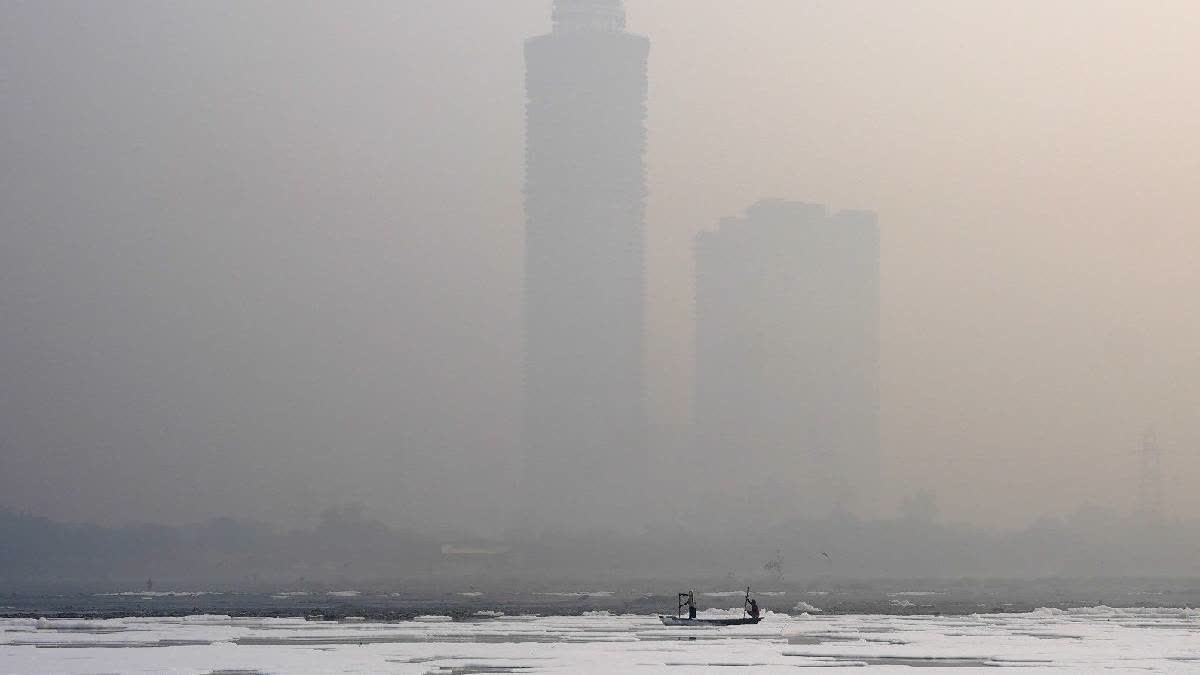New Delhi:For the 11th consecutive day, Delhi has been shrouded in thick smog, struggling with hazardous levels of air pollution. Despite the end of the festive season, the air quality remains alarmingly poor.
According to data from the Central Pollution Control Board (CPCB), Delhi’s Air Quality Index (AQI) hit 342 on Monday, classifying it as 'very poor.'
Delhi Chokes As AQI Continues To Remain 'Very Poor', Toxic Foam Engulfs Yamuna (ETV Bharat/PTI) Various areas across the city reported similar AQI levels, reflecting the city’s air pollution crisis scale. The System of Air Quality and Weather Forecasting And Research (SAFAR-India) further corroborates the grim situation, showcasing just how severe the pollution has become.
The air quality, however, is only one facet of Delhi’s environmental issues. The Yamuna River, one of the most sacred rivers in India, has also become a symbol of pollution and decay. This week, the Delhi High Court intervened, refusing to allow devotees to perform Chhath Puja on the banks of the Yamuna due to the dangerous pollution levels in the river.
"Please understand you will fall sick," the court warned, underscoring the health risks posed by the highly contaminated water. The court highlighted that the government had made alternative arrangements for Chhath Puja across 1,000 locations in the city, but unfortunately, the state of the Yamuna remains dire.
Despite warnings, thousands of Hindu devotees gathered along the Yamuna to celebrate Chhath Puja, performing religious rituals and immersing themselves in the toxic waters. Viral images and videos of the devotees wading through thick, white foam, a result of chemical waste and detergent discharge, serve as a stark reminder of the environmental degradation plaguing the capital.
A parliamentary report in February called the Yamuna “more of a toxic waterway than a river,” and the sight of devotees braving the froth-filled waters only adds to this grim reality. Women in traditional saris and jewellery were seen standing in the river as a white foam, dense enough to resemble ice, swirled around them.
The contrast between the condition of the Yamuna when it enters and exits Delhi is shocking. The river, which enters the city near Palla with relatively clean water, quickly degrades as it passes through Delhi.
Spanning 22 kilometres across the city, the river encounters a major drain approximately every 1.2 kilometres, each adding its load of contaminants. The primary polluter is the Najafgarh drain, which dumps vast quantities of sewage, industrial effluents, and toxic waste into the Yamuna. This and other drains ensure that by the time the river exits Delhi, its pollution levels are as much as 30 times the permissible standards.
Satellite images highlight two major froth hotspots along the river’s course through Delhi, near the DND flyway and Kalindi Kunj, where the river becomes enveloped in thick toxic foam annually. According to the National Green Tribunal (NGT) Yamuna Monitoring Committee’s 2021 report, high levels of phosphates and surfactants released by detergents are the main causes of froth formation. Despite calls for action, including recommendations to address illegal washing areas along the river, little has been done to curb the pollution.
In October, the Delhi Pollution Control Committee (DPCC) reported that 13 out of the city’s 18 drains had been connected to sewage treatment plants (STPs), yet some of the largest and most polluting drains, including Najafgarh, Shahdara, and Barapullah, remain untreated. These untreated drains are a major reason for the Yamuna’s continued pollution, with high levels of biological oxygen demand (BOD) indicating the presence of untreated waste. For instance, DPCC’s water quality data from October shows that none of the 18 drains met the acceptable BOD level of 30 mg/l, with levels reaching as high as 100 mg/l in the Shahdara drain.
By the time the Yamuna reaches Asgarpur, its BOD is recorded at 44 mg/l—an astonishingly high level compared to the recommended 3 mg/l or lower for safe water. These high BOD levels reflect the massive amounts of organic pollution in the water, which depletes oxygen and harms aquatic life.
Delhi’s pollution crisis is clearly multifaceted, affecting both its air and water quality. The challenges are immense, and the impact on public health and the environment is profound.
As Delhi residents brace themselves for another winter shrouded in toxic air and as the Yamuna continues to deteriorate, urgent action is needed. Cleaner technologies, stricter regulation of industrial effluents, and more comprehensive waste management are essential to tackle this crisis. Only through a concerted, multi-pronged approach can Delhi hope to see clearer skies and a cleaner Yamuna in the years to come. Until then, the capital’s struggle with pollution remains an unfortunate reality, with consequences that extend far beyond the city’s borders.
Read More
- Delhi: Chhath Puja Marred By Toxic Yamuna Foam, Severe Air Pollution
- Delhi: Rs 6,856 Crore Spent To Remove Toxic Foam From River Yamuna, Yet It Remains Dirty
